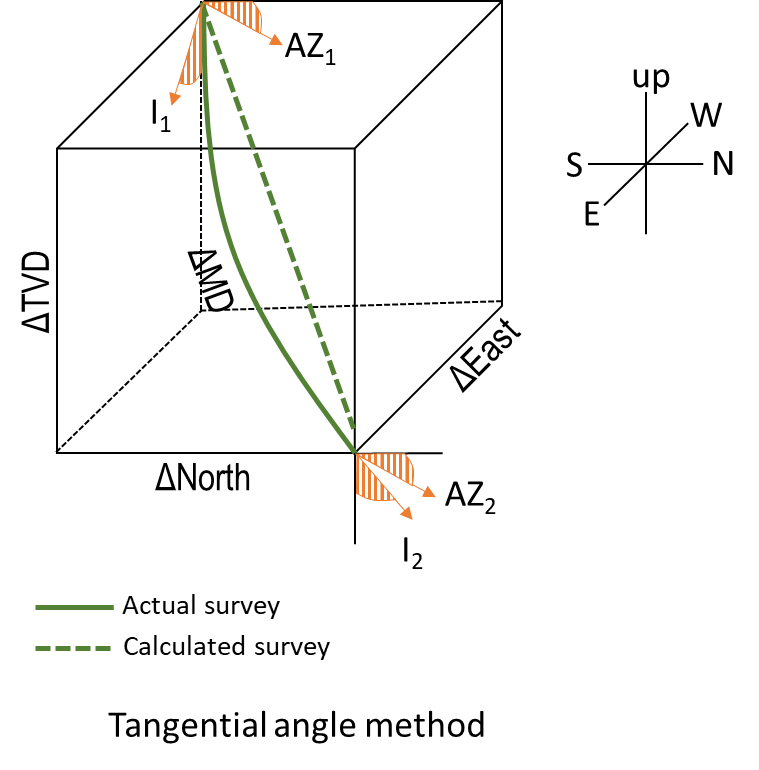There are several methods of computing directional surveys, in this case two methods are rewired: Tangential angle and Average angle
The tangential method uses the inclination and azimuth at the lower survey station assuming to be a straight line. The angles measured at the upper station are not used in the computing. This method is the most inaccurate when the trajectory is changing significantly between stations.

Tangential calcularions:
\[ \Delta North = \Delta MD * sin(I2) * cos(Az2) \]
\[ \Delta East = \Delta MD * sin(I2) * sin(Az2) \]
\[ \Delta TVD = \Delta MD * cos(I2)\]
where
\(MD = measured \ depth \ between \ surveys \ (m)\)
\(I2 = Inclination \ (angle) \ of \ lower \ survey \ (°)\)
\(Az2 = azimuth \ direction \ of \ lower \ survey \ (°)\)
R code
First, loading the survey data from CSV file, in this case we have: MD in meters, Inclination and Azimuth in angles, using read.csv tha data is loaded in dataframe format.
MD INC AZ
1 0 0.00000000 0.00000
2 15 0.03000000 86.60000
3 30 0.06000000 86.60000
4 45 0.01550349 96.85197
5 60 0.03000000 256.00000
6 75 0.02455922 247.22631For this method, two vectors are created, I2 and A2, to Inclination and azimuth of lower survey. With these vectors, just use the equation above to compute $ North$, $ East$ and $ TVD$.
I2 <- survey$INC[2:(nrow(survey))]
A2 <- survey$AZ[2:(nrow(survey))]
survey$TVD <- -c(survey$MD[1], cumsum(diff(survey$MD)*cos(((I2))*pi / 180)))
survey$DN <- c(0, cumsum(diff(survey$MD)*sin(((I2))*pi / 180)*cos(((A2))*pi / 180)))
survey$DE <- c(0, cumsum(diff(survey$MD)*sin((( I2 ))*pi / 180)*sin((( A2 ))*pi / 180)))
head(survey)
MD INC AZ TVD DN DE
1 0 0.00000000 0.00000 0.00000 0.0000000000 0.000000000
2 15 0.03000000 86.60000 -15.00000 0.0004657911 0.007840157
3 30 0.06000000 86.60000 -29.99999 0.0013973733 0.023520469
4 45 0.01550349 96.85197 -44.99999 0.0009131392 0.027550284
5 60 0.03000000 256.00000 -59.99999 -0.0009869108 0.019929599
6 75 0.02455922 247.22631 -74.99999 -0.0034757540 0.014001255Using Plotly package, the survey can be ploted in 3D
We can define a Kelly bushing and head values, as a servey start point, and computing the geographic coordinates and TVDSS
X <- 550000
Y <- 2500000
KB <- 33
survey$TVDSS <- survey$TVD + KB
survey$X <- X + survey$DN
survey$Y <- Y + survey$DE
head(survey)
MD INC AZ TVD DN DE
1 0 0.00000000 0.00000 0.00000 0.0000000000 0.000000000
2 15 0.03000000 86.60000 -15.00000 0.0004657911 0.007840157
3 30 0.06000000 86.60000 -29.99999 0.0013973733 0.023520469
4 45 0.01550349 96.85197 -44.99999 0.0009131392 0.027550284
5 60 0.03000000 256.00000 -59.99999 -0.0009869108 0.019929599
6 75 0.02455922 247.22631 -74.99999 -0.0034757540 0.014001255
TVDSS X Y
1 33.00000 550000 2500000
2 18.00000 550000 2500000
3 3.00001 550000 2500000
4 -11.99999 550000 2500000
5 -26.99999 550000 2500000
6 -41.99999 550000 2500000plot_ly(survey, x = ~X, y = ~Y, z = ~TVDSS, type = "scatter3d" , mode = "lines")
Reference Inglis, T.A. (1987) Directional Drilling. Petroleum engineering and development studies, Vol. II.